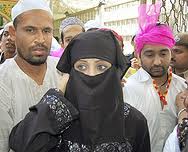dr vivek arya
A. Conversion of Hindus by Sufis
Sufis are considered as messengers of god who believed in peace, harmony and nonviolence. But contrary to this we read many evidences of Sufis using all measures to convert Hindus towards Islam. From debates, stipends, grants, higher official posts, life threat, pardoning of life to brutal killings were main tools for them.
1. Gisu Daraz famous Chisti Sufi (born 30 July 1321 in New Delhi) learnt Sanskrit and acquired a knowledge of the Hindu epics in an attempt to refute the religious beliefs in Hinduism. He indulged in debates with Brahmins on the condition that whoever was beaten should embrace the religion of the victor. Gisu Daraz claimed to have defeated many Brahman scholars.
(Ref. Gisu Daraz, jawanmi’u’l-kilam, British museum MS.or 252, ff.9a, 87a-90a)
2. Shahjahan ordered Mulla Muhibib “ali sindi, an alim, poet and Sufi whom he deeply respected to convert willing Hindus to Islam which would make them eligible for stipends and revenue grants”
(Ref. tabaqat-I-shahjahani, f.316b)
3. Sheikh dawud of chati converted fifty to a hundred Hindus each day would make the number of converts annually an impossible neat 15,000
(Ref. supra, p.63)
Sheikh dawud’s successor, shah abu’l-ma’ali, and Sufis in other qadiriyya khanqahs certainly never hesitated in their proselytizing mission and even Mulla shah converted a number of Hindus to Islam
(Ref. supra, p.119-120)
4. Shah ‘abdu’l-’aziz himself claimed to have converted hundreds of hindus, but was not successful in recruiting more than half a dozen shi’is to the ranks of sunnism.
(Ref.- malfuzat-I-shah ‘abdu’l-’aziz, p.22)5. A Hindu zamindar Birbar was arrested for fomenting a rebellion and was given the death sentence. He requested a Sufi Miran Bhikh to save his life and promising to become a Muslim if he did so. He was pardoned and was rewarded with a rode of honor. Sufi Miran converted him to Islam and also made him his disciple.
(Ref. HSI vol. 2 p.272-273)
5. According to Dara -Sukoh, Sheikh ‘Abdul-qadir converted a large number of Hindus to Islam, as well as causing many wayward Muslims to adopt a pious life
(Ref. Muhammad dara-shukoh, safinatu’l-auliya’, lucknow, 1872,p.69)
6. Sheikh Mahmud bin Abdullah gujrati was for several years deeply in love with the son of a Hindu dancer. The sheikh’s success in subsequently islamizing the boy was a matter of great satisfaction to the orthodox.
(Ref. Gulzar-i-abrar, f.247a.)
7. Nawahun, the Hindu darogha of Uch once visited Makhdum Jahaniyan (also known as Saiyid Jalalu’d-din Bukhari, eminent Suhrawardiyya Sufi) on his deathbed. He in his previous discourse had expressed that a formal recitation of kalima did not make the speaker a Muslim. The Saiyid concluded that Nawahun’s statement amounted to a protestation of faith. Nawahun was not willing to accept Islam. He even made an unsuccessful attempt to prevent his conversion from sultan of Delhi. But makhdum’s younger brother Saiyid Raju caught and executed him.
(Ref. HSI .by SAA Rizvi vol. 1 p. 279,280)
8. We know that the Suhrawardiyya, Shaikh lalalu’d-din tabrizi, Makhdum Jahaniyan and his brother, Raju Qattal, were active propagators of Islam. The Sufis trained in the khanqahs of Shaikh alaud-dala Simnani, Mir Saiyid Ali Hamadani and his son and successors, Mir Muhammad, considered the conversion of Hindus to Islam as one of their main objectives. Shaikh Jalal of Sylhet and his Turkistani disciples were similarly imbued with missionary fervour, as were Khwajgan and the Naqshbandiyyas of central Asia, some of whom would devote a few years of their lives fighting against the non-Islamic Turkic tribes before converting them to Islam. The Sufis of the Shattariyya, qadiriyya and the naqshbandiyyas orders who began establishing their khanqahs during the fifteenth century were deeply aware of the proselytizing traditions of their ancestors in Persia and central Asia, and brought their knowledge to bear upon Indian conditions in order to gain converts.
(Ref. HSI by SAA Rizvi, vol.2, pp.426)
B. Influenced Muslim rulers to show hostile behaviors towards Hindus to enable them to denounce Hinduism and accept Islam.
1. Saiyid nur-ud-din Mubarak’s gave four principles for protection of Islam. He was a Suhrawardiyya khalifa appointed by Iltutmish and was called by people of the city as, Mir-I dilhi (lord of Delhi)
The first one is as follows:
They (rulers) should promote Islamic customs, promulgate the commands of the sharia, enforcing what is obtained and prohibiting what is forbidden by it, and uproot kufr (infidelity), shirk (polytheism) and idolatry. If they cannot fully uproot kufr and shirk they should make every effort to disgrace and humiliate Hindus, mushriks (polytheists) and idolaters, for they are inveterate enemies of god and the prophet Mohammad. They should not tolerate the sight of Hindus, and in particular they should exterminate the Brahmans, who are the leaders of heretics and disseminators of heresy. They should not allow kafirs (infidels) and mushriks to lead an honorable life or sassing to them high office.
(Ref. tarikh-I firuz shahi, pp. 41-44)
2. Shaikh Muzaffar (Firdawsiyya Sufi) reminded sultan of Bengal Ghiyasu’d-din Azam shah that high government posts should not be given to Hindus and wrote:
An infidel may be entrusted with some work but he should not be made wali (chief supervisor or governor) so that he may have control over and impose his authority on Muslims. God says “let not the believers take for friends or helpers unbelievers and neglect god: if any do that, in nothing will there be help from god expect by way of precaution, that ye may guard yourselves from them. There are severe warnings in the Quran, the Hadis and historical works against those who have given authority to the unbelievers over the believers. God grants opulence and provisions from unexpected sources, and he gives deliverance from them.” There is authoritative promise of provisions, victory and prosperity. The vanquished unbelievers with heads hanging downward, exercise their power and authority and administer the lands which belong to them. But they have also been appointed (executive) officers over the Muslims, in the lands of Islam, and they impose their orders on them. Such things should not happen.
(Ref. S.H.Askari- the correspondence of the fourteenth century Sufi saints of Bihar with the contemporary sovereigns of Delhi and Bengal, journal of the Bihar research society, march 1956,p.186-187)
3. Mir Saiyid Ali Hamadani (founder of Kubrawiyya Sufi order of Kashmir) emphasized a covenant to sultan of Kashmir on his relation with Hindus. Covenant is as follows:
1. They (the hindus) will not bid new idol temples.
2. They will not rebuild any existing temple which may have fallen into disrepair.
3. Muslim travelers will not be prevented from staying in temples.
4. Muslim travelers will be provided hospitality by Zimmis in their own houses for three days.
5. Zimmis will neither act as spies nor give spies shelter in their houses.
6. If any relation of a Zimmi is inclined towards Islam, he should not be prevented from doing so.
7. Zimmis will respect Muslims.
8. Zimmis will courteously receive a Muslim wishing to attend their meetings.
9. Zimmis will not dress like Muslims.
10. They will not take Muslim names.
11. They will not ride horses with saddle and bridle.
12. They will not possess swords, bows or arrows.
13. They will not wear signet rings.
14. They will not openly sell or drink intoxicating liquor.
15. They will not abandon their traditional dress, which is a sign of their ignorance, in order that they may be distinguished from Muslims.
16. They will not openly practice their traditional customs amongst Muslims.
17. They will not build their houses in the neighbourhood of Muslims.
18. They will not carry or bury their dead near Muslim graveyards.
19. They will not mourn their dead loudly.
20. They will not buy Muslim slaves.
(Ref. Zakhiratul-muluk, pp. 117-118)
(Saiyid Ali considered Hindus as Zimmis)
4. Shah Waliu’llah suggested Mughal emperor Ahmad shah regarding their administration:
Strict orders should be issued in all Islamic towns forbidding religious ceremonies, publicly practiced by infidels (such as the performance of Holi and ritual bathing in the ganges). On the tenth of Muharram Shi’is should not be allowed to go beyond the bounds of moderation, neither should they be rude nor repeat stupid things (that is, recite tabarra or condemn the first three successors of Muhammad) in the streets or bazaars.
(REF. Shah Waliu’llah dihlawi ke siyasi maktubat, aligarh, 1950, pp. 41-44, 2nd edition, Delhi 1969, p.5)
5. Under the influence of Mir (Mir Muhammad Sufi of Kubrawiyya order) and Suha Bhatta, the sultan’s (Sultan Sikander of Kashmir 1389-1413) policy changed. Ancient temples in Pompur, Vijabror, Martand, Anantnag, Sopur and Baramula were desecrated and demolished; many puritanical and discriminatory laws were introduced and the jiziya or poll tax was imposed on hindus for the first time in Kashmir. The persecution of Brahmans, their exclusion from the top spheres of government and the ensuing replacement by Irani migrants, gave the administration a veneer of orthodoxy.
(Ref. HSI by SAA Rizvi, vol.1, pp.297)
C. Sufis promoted or participated in destruction of Hindu temples.
1.Miyan Bayan supported Bahadur Shah of gujrat to invade Rajputs and destruct Hindu temple.
In Ajmer, there lived Bayan Majzub who spent most of his time in the vicinity of the tomb of Khwaja Mu’inu’d-din Chisti. It is said that before his accession to the throne, Bahadur shah of gujrat (1526-1537) visited Ajmer, which was then ruled by the Rajputs who had gone to the extent of converting the tomb into an idol temple. Bahadur took a vow that if he were to succeed to the throne; he would take revenge upon the infidels and reduce them to miserable circumstances. Miyan Bayan who was present at the time instantly ordered his slave girl to arrange for a high throne for the sea bird, meaning Bahadur. The prince’s claim to the gujrati throne were strongly contested by his rivals. However, considering bayan’s symbolic gesture as a prophecy of his success in acceding to the gujrat sultanate, he immediately returned to gujrati and soon became its ruler. Shortly he invaded the Rajputs and shattered their power.
(Ref. akhbaru’l-akhyar by Shaikh ‘abdu’l-haqq muhaddis dihlawi pp.291-292)
2. Shaikh Jalalu’d-din of Suhrawardiyya Sufi order demolished temple and constructed a khanqah in place of it.
Shaikh Jalalu’d-din had many disciples in Bengal. He first lived at lakhnauti, constructed a khanqah and attached a langer to it. He also bought some gardens and land to be attached to the monstry. He moved to Devatalla (Deva Mahal) near Pandua in northern Bengal. There a kafir (either a Hindu or a Buddhist) had erected a large temple and a well. The Shaikh demolished the temple and constructed a takiya (khanqah) and converted a large number of kafirs.
(Ref. jamali, p.171)
D. Sufis appealed or helped Muslim invaders to invade Hindu kings
1.Shaikh Nur Qutb-i ‘ Alam and Saiyid Muhammad Ashraf Jahangir Simnani appealed Sultan Ibrahim Shah Sharqi to invade Bengal.
Shaikh Nur Qutb-i ‘ Alam believed in the traditional perso-islamic theory of kingship and taught his followers tom obey the sultan according to the prophet’s Hadis and the advice of leading Chisti saints. His relations with Sikander’s successor, Ghiyasu’d-din A’zam Shah, were cordial but he was distressed by the growing factionalism at court. A powerful party of Hindus and Muslims, led by Raja Ganesha, a local Hindu chief of Dinajpur in North Bengal began to dominate the government. After the death of Ghiyasu’d-din A’zam Shah, between 1410 and 1415, the Raja acted as king- maker and one after the other three puppets were elevated to the throne. During the reign of the last, Ala’u’d-Din Firuz Shah, Raja Ganesha was defacto ruler of Bengal. This prompted Nur Qutb-i ‘ Alam to write to Sultan Ibrahim Shah Sharqi of Jaunpur urging him to invade Bengal and in so doing restore the glory of Islam. Saiyid Muhammad Ashraf Jahangir Simnani also wrote a similar letter. In 1415 Sultan Ibrahim Shah Sharqi invaded Bengal but a peace was concluded in which Ganesha promised his son would convert to Islam before assuming the throne of Bengal.
(Ref. tabaqat-I-akbari, 3,p.265; gulshan-I ibrahimi, pp. 296-207; ghulam hussain salim, riyazu’s- salatin, Calcutta, 1890, pp.108-110, maktubat-I ashrafi (letter to sultan Ibrahim); mir’atu’l-asrar, ff.477b-79b; riyazu’s-salatin, pp.112-113)
2. Sheikh Ghaus of Shattariyya order of Sufis helped Babur to seize Gwalior fort.
For thirteen years and four months Shaikh Ghaus performed rigorous ascetic exercises in the caves of Chunar, near the Ganges in the modern district of Mirzapur in the U.P., and became known to the Muslim elite for his miraculous powers. He settled in Gwalior where he became very influential. In November 1526 he helped Babur’s army to seize the Gwalior fort, thereby winning the respect and confidence of the emperor.
(Ref. Beveridge, a.s.tr.Babur-nama, 2, reprint, New Delhi, 1970, pp. 539-540)
3. Saiyid Ahmad Shahid urged Muslims to help him in annihilation of Sikhs from northern India.
11 January 1827 he (Saiyid Ahmad Shahid) officiated at a ceremony of bay’a in which several thousand theologians, Sufis, leading citizens and common people in the northwest frontier pledged him their allegiance, after which they recited the khutba in his name. At the time Saiyid protested that as an Imam he was not commissioned to deprive the various sultans between Kabul and Bukhara of their states. They could continue to flourish in peace, he said, and would assert only his leadership in the question of bid’a (sinful innovations). However they were urged to offer him their military assistance in a jihad against the Sikhs.
(Ref. Muhammad ja’far thaneswari, ed. Maktubat-Saiyid Ahmad shahid, Karachi, 1969.no.14, 16)
E. Sufis unfriendly attitude towards Hindus
1.Shah waliu’llah advised Indian Muslims to live so far from Hindu towns that they would be unable to see the light from the fires in Hindu houses.
(Ref. shah waliu’llah, hujjat Allah al – baligha, 1, Karachi, n.d. pp.468)
2. He (Makhdum Jahaniyan or Saiyid Jalalu’d-din Bukhari of Suhrawardiyya order) also sternly disapproved of giving Allah such Hindi names as Thakur (lord), Dhani (rich) and Kartar (creator)
(Ref. siraju’l-hidaya, f.64b)
Sufis praised Muslim invaders who killed millions of Hindus, plundered thousands of temples, raped countless mothers and sisters and sold Hindus in slave market of Kabul.
It is not surprising that Shah Waliu’llah considered sultan Mahmud of Ghazna (998-1030) Islam’s greatest ruler as he launched and sustained the first read conquest of northern India. His fame had a natural qualification- Mahmud was the greatest ruler after the khilafat-I-khass. Shah waliu’llah argued that in reference to Mahmud historians failed to recognize that his horoscope had been identical to the prophet’s and that this fact had enabled him to obtain significant victories in wars to propagate Islam.
(Ref. shah waliu’llah, qurrat al-a’ynain fi tafzil al-shaykhyn, Delhi, 1893, p.324.)
Sufis didn’t hesitate to say lie for personal benefits
When mughal emperor aurangzib imprisoned his own son Shah Alam, his other son prince Azam shah believed that if Shah Alam were killed his accession to the throne would not prove too difficult. So Azam shah started hatching plots, using a Shaikh from Sirhind to whom the emperor was greatly attached. Azam deposited with a banker 900,000 rupees in name of the Sirhind Shaikh, on the condition that the latter incite the emperor to execute Shah Alam. The Shaikh informed the emperor that Shah Alam was an evil man who should receive the death penalty and that such knowledge had been given to him by the prophet. Owing to the seriousness of this accusation the emperor requested the Shaikh to mystically consult the prophet again, only to be told that the orders were final. The following morning the Shaikh called on the emperor, urging him against a delay in carrying out the express command of the prophet. Aurangzib summoned Sidi Faulad the kotwal, to whom he delegated complete responsibility in the handling of the matter. Sidi Faulad summoned every prominent banker in the imperial camp with their diaries and account books. The note about the plot hatched by Azam shah was found.
(Ref. HSI by SAA Rizvi, vol.2, pp.370-371)
NOW WITH THE ABOVE REFERENCES AND FACTS ITS VERY CLEAR THAT SUFIS ONLY MOTIVE WAS TO CONVERT HINDUS TO ISLAM AS FOR THEM HINDUS ARE KAFIRS.ITS MASS MEDIA WHICH IS PROJECTING IMAGE OF SUFIS AS SECULAR BUT TRUTH IS TOTALLY OPPOSITE TO IT.




No comments:
Post a Comment